The Small Press Expo is really two festivals, simultaneous and inseparable but nonetheless distinct – the one where cartoonists talk to other cartoonists (and publishers and journalists and critics) about their work and their craft and their inspiration, and the one where comics fans and curious people come to collect mini-comics, buy compilations, fill sketchbooks, get autographs, see what it’s all about and meet those cartoonists. SPX cartoonists are exceptional people. And SPX is, ultimately, not so much about comics as it is about cartoonists themselves – cartoonists as a source of creative inspiration for each other and for the rest of us.
When I attended my first SPX, I had a vague grasp of the idea of art comics but I had read very little – Eddie Campbell’s “Fate of the Artist” and Dash Shaw’s “The Mother’s Mouth.” I read the Shaw because I was writing a regular books review column for a Virginia-based magazine and Shaw at the time was living in Richmond, so it fit my “local author” requirement. The Campbell was specially and insightfully selected as the “Right Way to Introduce Caroline to Art Comics” by a friend who resisted giving me comics to read until “Fate” matched up with the things I’d said I liked about literature. (It remains, as everybody here knows, one of my favorite books period, of literature or comics.) So I was primed for the notion that comics were Art, but nonetheless not quite prepared for the headiness of SPX.
That first SPX afforded me the opportunity to speak directly about art – not just comics, but art and writing and criticism as well – with cartoonists like Austin English and Nick Abadzis and Juliacks, and with critics like Gary Groth and Douglas Wolk, and it gave me the opportunity to hear really intelligent panel discussions about making art, featuring not only Nick and Austin but John Hankiewicz, and Tom Kaczynski, and C.F. and Kim Deitch. Those conversations, passive and active, were about comics on the surface, but for me, without a lot of comics reference points, they were every bit as much about art in general – about inspiration, about making yourself creative, about doing the work.
I’ve had a similar experience at every SPX I’ve attended since.
After this year’s show, when we were all coming down from the high, Charles Brownstein of the CBLDF commented that “if you let it, [SPX] will reorient you towards comics as a spiritual pursuit,” and the sentiment gets at exactly what’s always made SPX so compelling. Until I started writing for HU, the culture of art comics in my experience was the culture of SPX. And the culture of SPX is extraordinary, because of those extraordinary cartoonists – 300 or so of them – and the conviction and imagination they bring to the show. I love comics because I love SPX. And I love SPX because the cartoonists’ passion for comics is an airborne intoxicant everywhere you go during the festival. At SPX, the cartoonist is the medium, transmitting the force and effect of comics’ potential to everyone in the room.
I think most people who come to SPX experience at least some of that intoxicating excitement, and I think we recognize it as one of the festival’s most valuable assets – especially for getting neophytes like I was to care more about comics and what they have to offer. Recognizing it, though, isn’t enough — we have to get that excitement airborne before the festival, so that it arouses curiosity in people who wouldn’t normally come to a comics event. And we have to get it into media that reaches that audience locally.
Coverage of SPX within the comics blogosphere is always strong (thanks everybody!). This year, advance coverage of SPX in local media was much more extensive than in any previous year – and we had a packed floor on Saturday as a result. 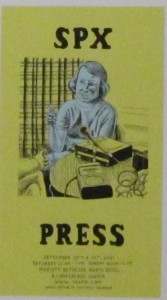 That coverage was due, again, to cartoonists: the festival’s slate of high-profile guests was exceptionally strong this year, thanks primarily to Executive Director Warren Bernard’s months-long efforts with publishers and individuals. But the coverage goes into something of a vacuum, because most non-comics readers, including many journalists, have little to no frame of reference when they see an article about alt-comics. Mainstream media outlets, even the indie alt-weeklies, aren’t attentive to the books and cartoonists through the year (they often don’t really do “arts” coverage at all.) Non-comics readers aren’t primed to think of comics as a medium rather than a genre; they don’t get historical references; they have different expectations from people who are already in alt-comics’ core niche. Editors either don’t see comics coverage as relevant, or they see it as relevant only for their calendar/events section. The good editors get someone who is “in the know” about comics to cover SPX – but then that skews the coverage toward the existing niche demographic.
That coverage was due, again, to cartoonists: the festival’s slate of high-profile guests was exceptionally strong this year, thanks primarily to Executive Director Warren Bernard’s months-long efforts with publishers and individuals. But the coverage goes into something of a vacuum, because most non-comics readers, including many journalists, have little to no frame of reference when they see an article about alt-comics. Mainstream media outlets, even the indie alt-weeklies, aren’t attentive to the books and cartoonists through the year (they often don’t really do “arts” coverage at all.) Non-comics readers aren’t primed to think of comics as a medium rather than a genre; they don’t get historical references; they have different expectations from people who are already in alt-comics’ core niche. Editors either don’t see comics coverage as relevant, or they see it as relevant only for their calendar/events section. The good editors get someone who is “in the know” about comics to cover SPX – but then that skews the coverage toward the existing niche demographic.
The problem of the expanded versus niche audience is of course something comics deal with all the time and in many contexts. On a panel devoted to “Navigating the Contemporary Publishing Landscape” (watch online at the SPX website), Fart Party cartoonist Julia Wertz, discussing her experience publishing Drinking at the Movies with Random House, commented that “what big publishers do is they just throw a lot of shit at the wall and they want something to stick, and comics don’t stick because people don’t buy comics. So the problem was that they put out this book and they had no idea how to market it, and I’d say ‘you need to send a copy of this book to The Comics Journal or to Tom Spurgeon,’ and they were like “what’s that?’…They were really nice, but they had no idea what to do with this book.”
I sympathize with those people at Random House, trying to sell mass general audiences a comic. The advantage of a press like that is their ability to put your book into the hands of a very wide audience. But it’s really hard to get across to the wide world of non-comics readers why a comic or a cartoonist matters. So many of our answers about why comics matter refer back to medium-specific, historical or nostalgic, comics-insider frames of reference that are largely meaningless to that non-comics reader. If your audience is really those people who already read TCJ and Tom Spurgeon, if your comic is made for comics insiders, then Random House’s broad reach honestly becomes a disadvantage. Wertz is surely right that comics insiders are the most likely people to buy her book and that the Comics Internet is the best place to market a comic. But things stick when there’s an affinity between them, so the question jumps out — is the audience of people currently reading the alt-comics Internet, the audience already familiar with alt-comics creators and vocabularies, the audience of people prepared and persuaded to consider mechanically reproduced comics as postmodern objets d’art, really large enough to support, economically and artistically, the critical mass of cartoonists needed to keep art comics and cartooning vibrant and vital as an expressive medium? Or do we have to build an affinity between comics and those expanded audiences, who may never be “comics insiders”?
One of the best things I did at SPX was talk to occasional HU commenter — and Ignatz winner for Promising New Talent! – Darryl Ayo Brathwaite, who has really thoughtful opinions about this topic. Darryl commented that “indie comic insiders tend to buy the critically acclaimed stuff, and the indie comic browsers tend to go for stuff that doesn’t get Comics Journal acclaim necessarily, but has a fairly easy hook.” An easy hook helps people manage the noise: “conceptually simple stuff appeals to people’s sense of wonder as well as to their sense of needing manageable answers in a room full of noise, both audio and visual.” I think he nails those “comics-civilians” and their buying behavior, but I think he also nails the essence of PR: identify and convey the hook, simply and directly enough that the message gets there in just a few seconds.
The truth, though, is that comics insiders get overwhelmed by noise too. And a catchy summation can help people grasp the value of a conceptually sophisticated book. It’s not either/or, really — conceptually simple or complex — what stands out most to me in Darryl’s observation is the importance of making people care, quickly and easily. As a frequent purchaser of both books and visual art, I often get stymied by art comics that don’t have good cover blurbs or creator bios. Sometimes it’s just plain impossible to tell what I’m holding without Googling it — or reading it. For a mini-comic, you just buy it anyway, because it’s $2, it’s handmade, and it looks cool. But it’s harder to rationalize the gamble for a $15 mass-produced book, and for me, impossible once the book costs $35-40. At a table in a noisy room, the blurb is the most immediate way to convey to a potential reader why the book matters enough to spend money on it. Fantagraphics’ blurb for Cathy Malkasian’s Temperance is excellent, just right for making the book jump out to a casual browser (even though they omitted an artist bio.) K. Sekelsky did a terrific job in one sentence on her illustrated book The Time Travelers Pocket Guide. Secret Acres’ compilation of Mike Dawson’s Troop 142 uses a catchy quote to strong effect.
But, those are narrative books. Tom Neely’s beautiful and conceptually challenging book The Wolf, in contrast, doesn’t have a blurb at all. It’s is a wordless comic, and I imagine it doesn’t have a blurb for the same reasons lots of wordless, “art-focused” comics don’t have blurbs: partly a) because it would visually disrupt the cover, but mostly b) because blurbs generally assert interpretations, and art-focused comics tend to value openness of interpretation, “make of it what you will.” I bought it because Charles Brownstein recommended it, but without his insider intervention I’d probably have passed over it: it’s visually arresting but it’s not really quite my thing (body horror and no prose). Charles, though, captured my attention — he essentially narrated a cover blurb. He got me past my first impressions and convinced me that the book matters, that it has something to say.
I know this suggests questions about whether comics are ontologically and commercially more like books or visual art, and raises philosophical issues about the Work of Art in the Age of Mechanical Reproduction. Comics are Art — but they’re an art that hides quietly on the bookshelf, unlike the oil painting over the piano. Does thinking of comics as art objects move them toward kitsch because of the status of reproducibility in the comics medium, or do books where the art takes center stage problematize the categories of kitsch and art, including allo- and auto-graphic permeability and the subjectivity of interpretation? Anybody who has talked to me about art knows those type of questions excite me, and I think the extent to which comics challenge our notions about materiality and value does influence why people don’t buy comics.
But I also want every exhibitor at SPX to sell out of everything they bring. Promotion — whether at the festival level or the individual level — lives in that realm of hooks and pitches, not at the level of critical ontology. The kind of hook that appeals to a comics-civilian browsing at a festival isn’t really that far from the kind of pitch that appeals to a mainstream journalist skimming through an inbox of pitches. Part of the mission of comics PR, I think, should be to balance the valuable and motivating intimacy of comics’ community of insiders against the need to identify accessible and relevant hooks to promote cartoonists and their books successfully to an outsider public.
It’s not a ready balance. Those outsider publics rarely think in terms of medium; they think in terms of content. In the case of film and fiction and television, each medium has many disparate markets and target demographics that align more with the genres and styles and content available in all of those media than they do with any medium itself. But comics is both a single medium and, to a great extent, a single market. Mainstream comics readers are more likely to buy and read the comics at SPX than are people who have no ties to comics at all. But those outsiders do have commitments to chick lit or procedural drama or postcolonial narratives or feminist cinema. To appeal to outsider publics and expand the audiences who read comics, comics PR has to find the places where the content and genres and styles of the comics medium overlap with those disparate markets. The biggest challenge is appealing to those content-oriented markets without sacrificing what is so joyful about the medium-driven community we have now.
Unfortunately, I haven’t had a chance to read anything I bought at SPX, and I was only able to spend about an hour in the exhibit hall. So here, until I have a chance to process a little, are some photos of what I bought. They’ll get a little bigger if you click on them; mouse over them to see cartoonists’ names and titles. Some things I wanted to buy and missed, like Darryl’s comics, and L. Nichols’ beautiful work, and many others on Rob Clough’s list of must sees. I also didn’t make it to all the Ignatz nominees’ tables. For those of you who were there, please tell me in comments what else I missed!

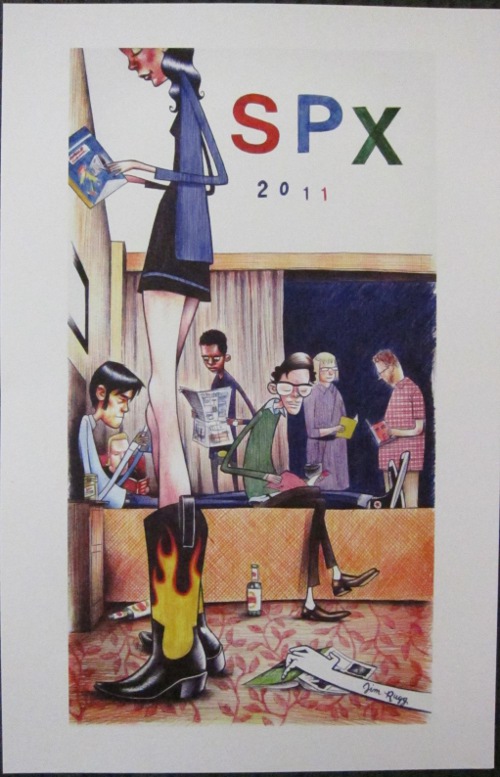
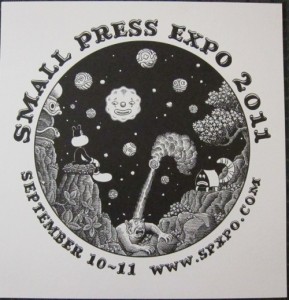
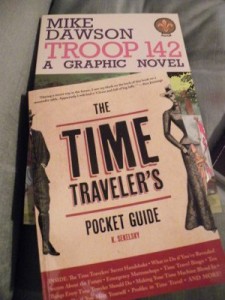
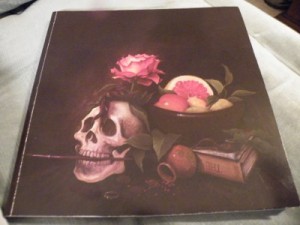

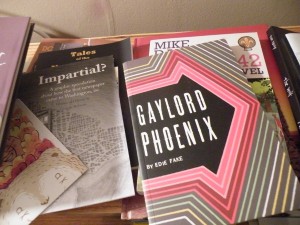
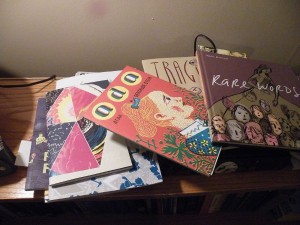



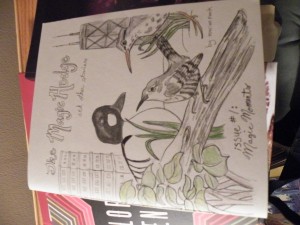


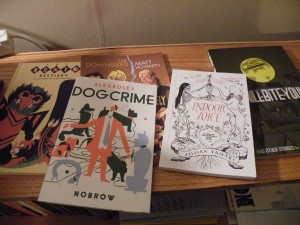
The mini-comics self-published market is essentially a craft outlet– which is not to dismiss it, since really good mini-comics creators (Edie Fake, Paper Rad, Ariel Schrag) end up crossing over to other audiences, art or TV or mainstream comics, and not in a marginal way.
A mainstream comics convention is basically a fan festival, which affects the content, and mini-comics are an artist festival, which also affects the content. In many cases that merely takes you from lowbrow schmaltz to middlebrow anxiety, but not all the time.
It’s interesting to think about this post in light of the conversation last week about DC’s efforts to attract new readers. I think those efforts are largely failing…but the fact of the failure is crossing over to mainstream outlets (Alyssa’s covering it, for example.
Which sort of reinforces my sense that comics as a whole would really be better off if DC and Marvel just stopped making comics. They drive the mainstream conversation to an inordinate extent…especially considering the fact that the audience for them is fairly small compared to other media.
Bert’s right that the audience for mini-comics is probably pretty limited…but at the same time, having the mainstream pulp face of the medium be decadent, dying dinosaurs can’t be helpful to anyone. I think it probably ties into what Caro is saying about many publishers not really knowing how to deal with comics….
Craft markets totally have an audience! What are downtown culture-walks and NPR for if not to promote middlebrow multiple art?
——————–
Noah Berlatsky says:
…Which sort of reinforces my sense that comics as a whole would really be better off if DC and Marvel just stopped making comics. They drive the mainstream conversation to an inordinate extent…
———————
Really; pretty absurd that sexually exploitative depictions of superheroines should create reactions like, “Should Feminists Give Up On Comics?”
Uh, there are other comics than Marvel/DC superhero crap, maa’m…
What we’ve got — in public perception, anyway — is the equivalent of the Republican/Democrat “duopoly”…
———————-
…having the mainstream pulp face of the medium be decadent, dying dinosaurs can’t be helpful to anyone.
———————-
Nope!
Short of M&DC throwing in the towel, though, what can we do to change the mainstream “face” of the medium? (Currently it’s not really a face, more an ahem, [insert gross-out body part of choice here].)
It’s partly that DC and Marvel are just abysmal ambassadors for comics but it’s also because DC and Marvel are so homogeneous and loud that a lot of people aren’t remotely prepared to think of comics as anything other than facile junk, so even when you say something to them that’s clearly NOT about facile junk, they don’t quite hear what you’re saying.
Bert…yeah, but most craft markets don’t sell mini-comics. They’re a craft with a really limited audience.
Is there a mainstream? Super hero fans are a small group who go to special stores to buy what are really fetish magazines.
I’ve always thought since “art-comics” do well at comics shows, they might do well at art, and arts and crafts shows.
It’s not just because they’re homogenous and loud; it’s because they own the rights to these characters that are very popular in other media. Lots of folks care about Starfire because she was in this really successful cartoon, or about Catwoman because she’s been in TV shows and movies and so forth. That’s why the mainstream covers this stuff. There’s an audience for the characters, even though no one really cares about the comics in which they appear.
Copyright reform would be helpful, actually, but that’s much less likely than the companies going out of business.
Hi Holly — I think there’s “mainstream arts culture” of which superhero stories are a fairly small part and superhero comics are an extremely tiny part. Art comics — and alternative comics which may or may not be “art” in any sense — really barely register on that scale. Mainstream arts culture like television and indie rock…comics has a pretty low profile in that segment of our culture. It’s a niche. Television isn’t a niche.
I think comics like Neely’s “The Wolf” probably would sell very well at an arts festival — the expectation of the attendees that the wares on display are “art objects” would work in its favor as it is really aesthetically compelling. But I don’t think we can just rebrand comics as “art objects,” or even focus primarily on art comics. The market for art objects that hide on bookshelves is still pretty slim, but also stories do still matter in most comics and stories with spines are books. Getting people who love and value books to care about comics should be a no-brainer…but it’s actually incredibly hard.
Noah, I think you’re overstating the popularity of these characters in other media. Starfire may be popular, but she’s no Rachel or Buffy or Hermione Granger. She’s not Snooki or Katie Couric or the Duchess of Cambridge, either (i.e., she doesn’t benefit from the glow of real-life celebrity…) I don’t think “lots of folks” care about comics period — sure, there are more comics fans who care about superhero comics than there are comics fans who care about alt comics, but there are just vastly more people who care about other media — or things that aren’t medium-specific — than there are people who care about comics period. Those people aren’t out looking for better comics, because they’re perfectly happy to find the instances of the content they like in another medium. Only a handful of people would give a shit if some smart alt cartoonist could provide a better version of Starfire.
And that’s the point when I say that from the standpoint of the mainstream press, comics is not a medium; it’s a market. A SINGLE market. No matter how hard we try to protest otherwise, from the outside, to people who have no personal exposure to comics, art comics have vastly more in common with mainstream comics than they do with mainstream fiction or film. SPX has more in common with Baltimore Comicon than it does with arts and crafts festival, or any book festival. M&DC could disappear tomorrow and that perception still wouldn’t change until we figure out a way to change it, because most people wouldn’t seek out a replacement…
That’s true about Starfire…but Batman and Spider-Man and Superman are really quite popular. Not Harry Potter popular, but they beat Buffy.
DC and Marvel are unlikely to go completely out of business…linked as they are to mega-corps like Warner’s and Disney. These little comics companies provide R & D cheap for movies that make big bucks (Bats, Supes, Spidey, X-Men, Thor, etc.) These characters could stay alive in people’s imagination without the comics…but with the constant churning out of stories about these characters (on the cheap) in comics…there is a constant circulation of stale ideas. Remember, Hollywood likes stale ideas. So does the public. Just not in the form of comics.
Sort them by year, though: in 2004, Superman and Buffy are tied.
And in 2009, for example, Superman is exactly as e-popular as Angelina Jolie
And In 2010, they all pale in comparison with Mr. Beiber.
And those numbers would go down FAST if you picked almost any other superheroes besides those three — even my mother could come up with those, because of their longevity.
I think you’re seeing the aggregate effect of comics corporate marketing and branding efforts, of all the fuss their corporate owners make about them. The cultural ubiquity of Superman and Batman et al. isn’t a measure of how much people care about them; it’s an artifact of their being ongoing franchises.
But other comparable ongoing franchises beat them by a significant margin: not only Potter, but Star Wars and American Idol. Twilight makes a fair showing, especially if you limit years, and even Survivor bests Superman…if you want to talk about things people REALLY feel emotional about, try adding in “Honda.”
“Ford”, “Apple,” and “football” also give some perspective… Although having searched, I think football being 15x more popular than superman might be depressing.
The number of times the use of Google Trends as some indicator of popularity comes up in the comments of this site is hilarious to me.
It’s because someone posts a link to it and then it’s like “ooh, toy!”
Clearly we need to do a google trends search on “google trends”.
Caro, my point isn’t that the superheroes are superpopular or more popular than anything else in culture, just that those characters (even Starfire) are way more popular than anything else in comics. They skew the perspective of the medium so strongly because they have a much higher profile even compared to comics that are more popular than the comics they’re in. Fun Home, for example; I’m sure that has sold more copies than any superhero graphic novel that isn’t Watchmen (or maybe a couple of others.) But comics are still associated with Superman because Superman sells much better than Fun Home in these other mediums.
Hi Caro, By “art” I don’t mean gallery art, but rather what might be called “art festival” art. And I’m not trying to puff up the one and denigrate the other. Gallery art is more like the Opera. Art fairs and crafts fairs are more like a Main Street farmers market, dress is casual, prices are lower, purchases are casual.
It may sound crazy, but as far as book stores go I think the death of Marvel and DC would have a positive effect on comics. As it is I can’t quite escape a slight sense of embarrassment when I’m in the comics section of a chain bookstore. If the super hero material went away comics would take on a different aura.
I just wonder, since we’re completely now talking about culture as economics (instead of economics as culture) is the idea that mini-comcis creators are more spiritual than mainstream creators, just because maybe their work is, for many thoughtful people, slightly more aesthetically bearable (if slightly more smug)? Or was that ever the point?
I think there’s also a boutique market in mini-comics, in which is crosses over to other kinds of small-run fancy publishing, and some artists (like Edie Fake) are in “real” art shows all the time… is Caro wondering if there is then no hard and fast line between Ditko and Duchamp and tattoos (which Edie also does) and Thomas Kinkade and professional ceramic jewelery and paint-your-own cerramics? Because that would be fine by me.
Bert, I think, yes — no hard and fast line. Only the line we make. But the line is hard enough that it’s difficult to remake it…
I don’t think there are relative levels of spirituality associated with any art practice over any other art practice — but there are situations where it’s harder to be spiritual about art than others. It’s a matter of psychology, not ontology. Marketing traffics in the psychology of spirituality — how do you make someone care?
I’ve never seen a comic (art or otherwise) at a craft fair (I used to sell crafts, long story), but it does look Etsy has a nice selection. I hope that takes off. I’m mighty tempted by the rubber chicken coloring book I just stumbled on, actually….
http://www.etsy.com/listing/81682994/rubber-chicken-coloring-book-by-dingo?ref=cat2_gallery_16
Fabulous, fabulous article. You’re so succinct and sober when describing something you’re obviously passionate about.
I’ve lost the will to go back to SPX and similar events because I always come away demoralized. I used to rationalize this feeling as being unable to fit into an exclusive and cliquish environment, but in truth just don’t have the personality to thrive in that kind of networking situation. I need to really be ready before I can go back there again (if I can even get a table by now).
It’s really cool that all this excitement is coalescing around the event, and that it inspires these really interesting (and relevant!) questions.
Thanks, Michael! I’m really glad you enjoyed the piece. :)
I have another friend who feels the same way about SPX, that it’s just too overwhelmingly social for him. It’s very exciting for me but I sympathize. Someone told me his way of enjoying SPX was just to hang out quietly in the back of the panels and absorb what people were saying, so I do think there’s a way to get something out of the show without Extreme Networking. (You can also watch the panels as they show up on our website.)
I do welcome any suggestions people have for things that we could add or do that would make the show more enjoyable or meaningful for them. I think everybody on the SPX Steering Committee is really enthusiastic and ambitious about the show; hopefully 2012 will be even more exciting and rewarding and well attended…
Also, we’re adding more tables next year (and will also have widre aisles) so you could probably get one… :)
Oh man, I just remembered how I meant to ask if anyone saw the Simpsons episode where Comic Book Guy loses all his business to this super hip new comic book store where kids are encouraged to read in the store, and there’s a panel with Dan Clowes, Alan Moore, and Art Spiegelman (who all turn into superheroes at one point), and the owner’s girlfriend is named Strawberry and her purse is a lunchbox (score one for my indie-craft/mini-comics subcultural crossover theory).
Did anyone on this blog have feelings about that episode?
—————–
holly cita says:
Is there a mainstream? Super hero fans are a small group who go to special stores to buy what are really fetish magazines…
——————
Lest we look down too much upon the fanboys, aren’t there loads of books and magazines catering to special interests? There are magazines which focus on football, pro rasslin’, cars, guns, fashions, dolls, WW II, movies; a BIG portion of book-publishing is genre-driven (mystery, romance, fantasy, SF, horror, the fare routinely as codified and formulaic as in superhero comics…
The batch of stats at http://humorwriters.homestead.com/startlingstats.html mentions how “A successful fiction book sells 5,000 copies. A successful nonfiction book sells 7,500 copies.” Even if the price is higher, those sales figures are comparable to an average-selling comic.
http://www.nytimes.com/2009/04/08/books/08roma.html?pagewanted=all tells how, while overall book sales are down, the escapism available in romance, SF and fantasy novels is boosting their sales. The article goes on to note:
——————-
Romance readers are considered among the most loyal fans, sticking to a series or an author once they have grown attached to one. “It’s a very dedicated audience who doesn’t see it as a luxury as much as a necessity,” said Liate Stehlik, publisher of William Morrow and Avon, imprints of HarperCollins Publishers.
The romance genre may also be especially attractive to consumers during difficult economic times because so many of the books are sold in the mass-market format, smaller paperbacks often found on racks at the grocery store or in airport bookshops…
Romance readers have always tended to buy in much higher volumes than people who read other genres like literary fiction. So even though some romance readers may be cutting back — Sue Grimshaw, the romance buyer at Borders, says people are buying four or five instead of five or six books a week — they are still buying more than readers of other book categories…
———————
Hmm! Sure sounds awfully like the stereotype going to the comics store on that Very Special Day, to pick up his weekly superhero fix…
S’more book statistics: http://www.rwa.org/cs/the_romance_genre/romance_literature_statistics/industry_statistics
http://www.msnbc.msn.com/id/20381678/ns/us_news-life/t/poll-one-four-adults-read-no-books-last-year/
…And while creative work in a genre is also looked down upon in general, it also makes it far easier to sell/i>; the prospective readers know what they like, and if an unfamiliar book is clearly in a genre they’ve enjoyed, they are far more likely to get it.
When getting videos at the public library for the Missus and me to watch in our few evenings together (been working a lot of nights), though there is a vast array of other stuff available at no cost, virtually everything I borrow are British TV murder-mystery shows. Excellence and a satisfying viewing experience are a certainty! While other fare is definitely hit-or-miss…
Looking at the photos of Caro’s SPX purchases, they’re intriguing and offer a wonderfully varied assortment of styles. But, can you tell what those books are about from the covers?
———————
Caro says:
At a table in a noisy room, the blurb is the most immediate way to convey to a potential reader why the book matters enough to spend money on it.
———————
Not to mention, in such a situation the creator is right there. If a cover doesn’t strongly appeal, I’d rather skip the whole “pick up the book and flip through it, while its creator is watching your reactions and hoping you’ll buy it, then hurt their feelings by deciding their ‘child’ is not worth the cost, or doesn’t look like your cup of tea” experience. (I’ll do this in art shows too; not even duck into a painter’s booth unless I like their work, ’cause I’d be raising false hopes that they’d make a sale.)
I think even better than a blurb would be the comics equivalent of a movie trailer. A removable, separately-printed page – wide or narrow – that would wrap around the cover, showing a selection of panels from the book that would give an indication of what the book’s about, its creative “flavor.”
And there are some self-contained sequences which could also do the job:
http://madinkbeard.com/blog/wp-content/images/hernandez-flies1.jpg
http://picturesofeverydaylife.files.wordpress.com/2009/12/locas2.gif?w=550&h=696
http://www.austinkleon.com/wp-content/uploads/2007/01/israel.gif
(Someone with a table featuring their book could just have this “trailer” blown up as a stand-up display, rather than putting it over the covers.)
———————
holly cita says:
I’ve always thought since “art-comics” do well at comics shows, they might do well at art, and arts and crafts shows.
———————-
But, you read a comic, and then stick it on a shelf; arts and crafts are purchased to display…. (As Caro neatly put it, “The market for art objects that hide on bookshelves is still pretty slim.”)
Even from the perspective of what you called “…’art festival’ art..more like a Main Street farmers market, dress is casual, prices are lower, purchases are casual,” the product purchased is still meant for display.
And, this isn’t even taking into account the dismal economic situation, and how it’s negatively affected discretionary spending…
——————-
Caro says:
I don’t think there are relative levels of spirituality associated with any art practice over any other art practice — but there are situations where it’s harder to be spiritual about art than others…
———————
Yes; like the difference between someone for whom it’s a job, where they have to crank out X number of pages dealing with some company-owned character per month in order to pay the bills, and someone who does it almost solely for the love of it, pursuing whatever path appeals to them.
Which doesn’t automatically make the first example a hack — even a great like Kirby could fit there — nor does it necessarily mean the second creator’s work would be of any merit or substance.
But, that job grind can sure eat your soul…
———————-
Bert Stabler says:
Oh man, I just remembered how I meant to ask if anyone saw the Simpsons episode where Comic Book Guy loses all his business to this super hip new comic book store…
————————
Loved it! (I’ve read that Matt Groening hits the comic book store once a week…)
Bert, I haven’t seen that episode, but I think the basic insight (new subculture same as the old subculture) is sound enough. It’s worth pointing out though, that Alan Moore used to work for DC…until they gratuitously and shamefully fucked him over, then fucked him over again, then kept fucking him over for years, and they are still essentially fucking him over right now, even as we speak. And they didn’t do it because they hate Alan Moore. They did it because that’s how they routinely operate.
There are a lot of great superhero books, and so in theory someone could make a great superhero book for Marvel and DC again I guess. Elektra Assassin is better than the vast majority of mini-comics. But despite such exceptions, those companies are pretty evil even by the abysmal standards of media conglomerates, and the product they are currently putting out is, by and large, unbelievably awful, in that I literally can’t believe how bad it is. (Have you seen any superhero comics made in the last five years?) Their business model is egregious, and their politics are as well.
Art comics and mini comics certainly don’t operate outside of commerce, and they aren’t innately better than pulp crap. But they are *signiciantly* better than contemporary superhero comic pulp crap, because contemporary superhero comic pulp crap is really, really bad. Trying to figure out a way to exist that doesn’t involve being bundled with that steaming pile of cow dung may seem kind of desperate and ridiculous and futile — but running from Jason is desperate and ridiculous and futile too. But what are you going to do? Even if it’s desperate and ridiculous and futile, you’ve got to run.
Having said which, it’s worth noting that I still think In The Shadow of No Towers is the worst comic I have ever read. And Jeff Brown’s stuff probably isn’t any better than that new issue of JLA #1…
Now I’m just depressing myself.
Mike, the creator isn’t always at the table at SPX — sometimes they’re listening to a panel, but also people bring their friends’ and colleagues’ work to sell at their tables. For example, I finally got a copy of Austin English’s “The Disgusting Room” from Tom Neely’s table, but Austin wasn’t there. That’s even more likely with the “big” small presses, although they tend to more consistently use blurbs.
Darryl also raised the very valid point that a lot of people don’t want to start a conversation with someone if they might deny them money, and I think that’s also true — if people are curious about a comic but not sure, they might not want to have to say to the cartoonist’s face that they’re not going to buy it. The blurb allows for some privacy in that browsing process.
Excerpts are always good ideas — if you haven’t already, check out the excerpts of the Ignatz nominees on the SPX website — but they serve an entirely different function from blurbs, I think; blurbs are meta, I guess. They either tell what the book is about or they identify what the context is or they tell why the book matters.
Blurbs are an invaluable tool of book marketing, which is why I think the resistance to them is an artifact of people thinking comics are either not books but art or a special class of book. I think there’s a discomfort with the term “comic book” — “comic” has become the noun, not “book.” There’s an ontological implication to that (to get at Bert’s question a little bit of what my ontological committment is here.)
But pragmatically, if you want to draw book readers into reading comics, you need to hit their familiar marketing points, so they feel comfortable and so the book is contextualized in a way that allows them to get it. If you make it too “insider-y” then the civilians will be uncomfortable and move to stuff that, as Darryl says, has an easy hook. IMO, it doesn’t inherently require a change in the content or the presentation, just some effort to figure out the best way to adapt book marketing to comics. Fantagraphics is really good at it — but I also think they select books that lend themselves to this kind of marketing.
Although, that said, what I kept thinking when you were talking about genre fiction is that genre fiction is more diverse than this. Yes, there’s formula romance that fits your description — but there’s also chick lit and both contemporary and classic literary romance which don’t. There’s a lot of gothic romance; Twilight fits into that genre, in a very unsubtle way, and the new Dark Shadows appears to be a campy gothic. Cozies are also a highly feminized genre, “romance” in the older sense, overlapping between romance and mystery. Science fiction is even more diverse as a genre – there’s just a hell of a lot of genre fiction out there.
So I mean, yes, a significant percentage of book publishing is very genre-focused — but “genre” is a much more diverse category in fiction than it is in comics. I think this is part of why it’s so hard to convince people that comics is a medium rather than a genre itself — there isn’t enough diversity of genre fiction being made in the comics medium to throw the medium-specific elements into relief in a very sophisticated way. M&DC comics are basically their own single genre, derivative from other genres but not instances of those genres, and there really aren’t a lot of alternative genre comics period. Alt-comics at present really runs the risk of being viewed as a 2-genre form: memoir and art comic.
The point I was getting at in the last paragraph above is that genres are non-medium-specific — science fiction fans will like SF TV, SF movies, and SF books. Ideally they should also like SF comics — but there just aren’t enough SF comics to choose from. There’s Carla Speed McNeil’s books — and what else? With M&DC’s implosion (I don’t care that it’s only DC; as far as I’m concerned they are one evil ubercompany), I think comics is missing a great opportunity to fill a need in the mainstream market for alternative genre work that draws on the Western traditions of genre entertainment. We’ve let manga fill that need, and that does a disservice to the Western genres.
Although I do think genre entertainment is kind of at a nadir overall – I just recently read an article about the paucity of genre TV this season. There does seem to be a generalized suspicion of it. But good genre is a great way to get people interested in a medium, because the continuity of content gives an entry point into the unfamiliar aspects of the presentation. And I can’t help but wonder whether the mainstream entertainment sector’s reliance on M&DC for genre content isn’t at least partially responsible for the decline in quality genre work overall.
“There’s Carla Speed McNeil’s books — and what else? ”
There’s Y: The Last Man.
You really think there’s a dearth of genre on television? There’s tons of detective and crime stuff; there’s that George R.R. Martin miniseries; Torchwood’s still out there..as is Dr. Who, isn’t it?
I think it’s more reality tv that’s reduced genre offerings than superhero fare, probably. There doesn’t seem a lack of genre content in film, anyway; there’s hardly a dearth of spy/assassin movies, for example.
I should write more on this, but Dr Who apparently has decided that it’s more important to dissect and critique the superhero genre is than to actually be Dr Who. Which I find boring, even though I agree with the sentiment. They’ve built this whole storyline around “debunking the myth of Dr Who as a superhero savior” — which they’re doing quite effectively, except that Dr Who was never a superhero savior. Dr Who was a different KIND of superhero. His “powers” were imagination, lateral thinking, confidence, all kinds of things that anybody can develop in themselves. That’s why it was great as a kids show: it was about the value of problem solving. Superheros solve problems by magic and force, and Dr Who never did that — but now he does. It’s kind of heartbreaking.
I’ll try to find the article I read, but I think mostly there’s a lot of BAD genre TV…And I’m sure reality TV — and its low, low cost — is ultimately to blame. But I doubt abysmal comic-book genre work is entirely without culpability.
Here’s the article.
“if people are curious about a comic but not sure, they might not want to have to say to the cartoonist’s face that they’re not going to buy it. The blurb allows for some privacy in that browsing process.”
And thus why I probably come off as an unfriendly jerk when browsing at shows. I know I’m not going to like 90-99% of what’s there, so I find it hard to be friendly with people.
Or I end up being friendly with people then feel obligated to buy something from them.
You need to leave your wallet in the hotel room or something! Or pretend you have….
Yeah, it’s a huge problem at shows. It intimidates people. I hope cartoonists understand that people have budgets, and people sometimes think about books for awhile before they buy them, and also just that not everybody is going to like every thing. I can really admire a cartoonist for a lot of reasons without having their work match up with my taste.
I think Vom and Holly’s observations about Etsy are great here: if all the exhibitors had an Etsy site where their stuff would be for sale after the show and ongoing, then they could pass out cards with the link to their etsy site, or little mini-catalogs with all their work listed — friends could even go in together for a single etsy site, a distribution collective which would basically be a “micro-press” — and then you could take their card after you talk to them and later go to the site and think about what to buy.
A convention then becomes a place to get people’s attention, help them understand what your work is about and who you are — basically brand recognition, more purely about marketing and less about sales. I think, at least, that this is sort of Darryl’s idea. It shifts the focus of a convention from sales to marketing and programming, which is more like a film festival and less like a comics convention. And I think that’s important for reaching out to new audiences, because the term “comics convention” has nerd-fright connotations that scare a lot of people off.
Not that there won’t still be sales, because it’s FUN to buy comics at SPX. But I think it’s an important expansion of the purpose for getting a table…
Ohhhhh…I just skimmed that article. The mistake is the assumption that sci/fi and fantasy are the only genres, or even the historically most important genres in television. The Wire is a genre show. Deadwood is a genre show (haven’t seen it, but it’s supposed to be good.) Even something like Weeds is a genre show if sit-coms are genre, which they probably are.
I like sci-fi and fantasy too, but cop shows and mysteries are more popular on television, and have been for a while. On the other hand, fantasy seems to be hugely popular in books ( harry potter, twilight, hunger games.) Can’t win them all.
Yeah, the site is an SF site, though, which is why it’s implied and not stated.
But I think the point is the diversity of genres: TV is loaded with procedurals and forensics, but it’s still pretty homogeneous even within the crime genre. There aren’t cozies, espionage was underrepresented (although it looks like this season may address it), 24 was a one-off on the political thriller front. Hawaii Five-O is an outlier in the cop buddy-show genre. Sit-com is a genre, yes, but it’s a pretty medium-specific genre that actually probably works against good genre tv in the broader sense: for example, the mini-series romance that was common in the ’80s is gone. Evening soaps are basically gone (daytime soaps are basically gone!) There are no “contemporary westerns” — which is the category that I’d loosely put shows like MacGyver or the A-team or even The Dukes of Hazzard in — and Deadwood is also a one-off in historical Westerns (not that I miss shows like Dr Quinn or Little House, but they were Westerns targeted at WOMEN.) And SF and fantasy are kind of pathetic; the article that linked to that article was one about how there is no space opera on TV this season for the first time since the year before Next Generation premiered…
If every spot that’s taken up with reality TV and sitcoms were taken up with really well-written genre programming, that would be a golden age of genre TV. We definitely don’t have that…TV writing is BAD. (Let me point you to the first 15 minutes of the new Charlie’s Angels if you’d like an example of how bad. O.M.F.G.)
Bones is actually more mystery/cozy than crime, despite all the gruesome dead bodies. The writing’s not bad either — not great, or anything, but the banter is okay. Watching pretty people banter in a non-cringeworthy fashion; that’s all I ask from television, really.
Weeds wasn’t bad as a kind of sit-com/crime-heist/farce hybrid. It did fall off a cliff admittedly.
I think it’s really reality TV that’s sucking up space…and reality TV is it’s own genre now, right? Is reality TV significantly worse than genre tv (like Charlie’s Angels)? I don’t think I’ve ever seen a reality show, so I’m not really in a place to evaluate.
Noah: “Alan Moore used to work for DC…until they gratuitously and shamefully fucked him over, then fucked him over again, then kept fucking him over for years, and they are still essentially fucking him over right now, even as we speak.”
The V for Vendetta movie is certainly a good example– I can’t remember if the book was all that, but the movie was awful. But, on the other hand, now the V mask is a signifier for the protestors on Wall Street. Righteous.
But no, I haven’t read recent mainstream superhero comics, and you can’t make me.
The end of that Simpsons is great– Alan Moore and Dan Clowes and Art Spiegelman fly away at the end to attend a fundraiser for underpaid comic book artists and writers of the ’30s.
Inherently worse, or worse for the goal of good genre tv? If the goal is good genre tv, then it’s clearly pretty bad for it.
I think the problem is there are two categories of genre here: narrative genre and medium genre. Sitcoms and reality tv are not narrative genres, but SF etc. are. Medium genres work off of things other than strong narratives…they tend to be personality and character driven, so they just don’t require writing as subtle as narrative genre work does. The writing skills you need for gag humor are very different from the writing skills you need to sustain a season of space opera.
So to me, that’s why they’re bad — they diminsh the opportunities for good genre writers, and if you don’t have opportunities for them, those writers will go elsewhere, which makes it even harder to create good genre TV and damages diversity even more…
“But no, I haven’t read recent mainstream superhero comics, and you can’t make me.”
I think there’s a Geneva convention that applies to that…
Derik you never have to buy anything from me. Just come on out and say hi! I might not even have stuff for sale at next year’s round of shows!
Thank you Caro, talking with you and sharing my crazy festival ideas was a high point. To expand on a point you recalled in the comment above, I envision a comic festival one day without a selling floor. But rather a vast expanse of booths or tents which publishing companies or art houses can set up intimate displays for people to experience. Like galleries of original art, displays of prints and other close-up, non-sales scenarios.
The only commerce would take place in a single booth, similar to a museum shop, which relieves all of the financial pressure from the show floor.
Also: more panels, there should be panels upon panels. Less PR panels, which aren’t a problem at SPX and MoCCCA, but are problem at mainstream hero shows. More pointed discussions, interviews, q&a sessions. And then activities! Comics are fun! Get Dave Roman or Colleen AF Venable to do workshops with kids and teens.
And as for promotion: I’m just about finished with comic press releases to the comic press. Do press releases to the area of interest for the particular comic. Break it to external media before newsarama or the comics journal.
I don’t like to tell people how to do their jobs but if the comic-market is shrinking, it’s clear as day that you’ve got to push the stuff outside of said market, right?
Stop blaming the economy, let’s sell some comics, let’s have ourselves a stronger culture!
Noah: You should watch Deadwood (haven’t Alyssa recaps got you interested?), it’s my favorite tv show (or at least it’s tied with Buffy).
Darryl: I’d buy a Little Garden book from you, I’ve been enjoying them on your site.
On the photographs: “The Gremlins Movie Incident” is a mini-comic featured in the center right photo. SPX just posted a video interview with the cartoonist, Cara Bean.
Darryl – I went to my first B’more ComicCon after my first SPX and I was all prepared to learn something from the panels but NO. PR panels all the way. Yikes. They’re HORRIBLE. They don’t even work as PR for people who aren’t already inclined to buy the thing. I agree that kind of shallow, transparently and profoundly non-spiritual PR does not benefit comics in any way shape or form.
Maybe that answers Bert’s question from yesterday a little bit more directly: I don’t think this applies to creators, but I do think that substantive PR, created by people who really love the work and the form and who want to share that that passion with the world, is “spiritual” in a way that lowest-common-denominator, insulting to readers, exclusively commercial PR is not. PR can be about infecting the readership with enthusiasm and passion for the art form and for specific works, or it can be about trying to dupe or pander in order to make as much money as possible with as little work as possible. It isn’t a requirement that PR about superhero comics be shallow, but it is how it tends to play out, apparently.
The panels at SPX aren’t really PR at all for the most part; they’re very very substantive, thanks to the efforts of programming director Bill Kartalopoulos and the cartoonists themselves who are always really smart and intereted in talking about substantive things.
Alt comics does have a bit of a problem in that the best kind of PR often gets confused with criticism. Really good PR needs critical thinking, but it’s a different genre. But I don’t think that means PR is bad, just that it’s worth realizing that PR is PR.
In related news, Matt Thurber has made a trailer for 1-800-MICE.
I just tabled at the Massachusetts Independent Comics Expo this past Saturday. The show just flowed with people all day long – I didn’t leave my table to walk around until nearly the end of the day.
I’m convinced that MICE’s biggest success factors are its free admission and its access to public transportation. This helps people to visit easily and stay for as long/short as they like without feeling like they’ve wasted admission fee.
It’s encouraging for families with young kids, people just passing by, and non-comics fans. I got plenty of interest from my non-comics-reading coworkers, and I had many people pop by my table who were just in the neighborhood and decided to stop by.
This probably isn’t an approach that SPX can use, but it’s something to consider if you’re running a small-scale indy show with the goal of community outreach.
(Disclaimer: I’m a member of Boston Comics Roundtable, who co-hosted MICE, though I was not on the organizing committee)
Spiritual PR! I wonder if John Locke could underwrite that… this book I’m reading is leading me to believe that he was the closest thing to a mystical capitalist, at least up until Timothy Leary.
Truly, DIY is just a longer acronym for PR. But I love it anyway– at least on a spiritual level.
Timothy Leary and Deleze.
DELEUZE. Dagnabbit.
Pingback: Comics A.M. | Janelle Asselin exits DC; Del Rey’s Betsy Mitchell retires | Robot 6 @ Comic Book Resources – Covering Comic Book News and Entertainment
Noah said: “Bones is actually more mystery/cozy than crime, despite all the gruesome dead bodies.”
I don’t understand why people can’t do straight genre without interjecting body horror. It’s a massively huge problem for me in alt-comics, ’cause I really kind of hate body horror and for whatever reason it is increasingly ubiquitous. If it’s not actual body horror, it’s scatology of some sort. It doesn’t gross me out — it’s _boring_. It reminds me of the grubby boys in the back of my middle school class. I wish somebody would explain if there’s actually a conceptual goal.
By definition, though, body horror isn’t “cozy.” Even wikipedia says “Cozies very rarely focus on sex, profanity or violence. The murders take place off stage, and are often relatively bloodless (e.g. poisoning).” I can see Bones as mystery, I guess, although I think its character and tonality don’t exactly match to the literary genre, but I stand by the claim that cozies are absent!
So here’s me trying to spread the word.
Oh, and re: body horror — boys like it. It’s a way for Bones to appeal to guys as well as to a more cozy female audience, I think.
From your article: “yes, feminists should give up on DC and Marvel, as should all other sentient entities.”
Ha ha ha. Perfect.
I would totally watch Bones if there were dangling eyeballs. Are there dangling eyeballs?
I’m with Bert! Eyeballs in their sockets are boring, unless they’re being licked.
Caro: “I wish somebody would explain if there’s actually a conceptual goal.”
I suggest some stuff here, recommending Videodrome and In My Skin.
Thanks, Charles! Do you think most instances of body horror are going for that same concept?
I would still have a philosophical problem with the “distrust your body” meme. It seems like a punk-aesthetics version of old-fashioned Cartesianism that emphasizes all the worst anti-feminist bits instead of the aspects that are worthwhile. It does seem like a potentially powerful explanation of why I find body horror (and often, punk in general) so off-putting though.
Abjection is pretty thoroughly theorized from lots of different directions. It has Freudian implications; it has Christian implications, it has feminist (and anti-feminist) implications. I don’t know that there’s that much of any of that going on in Bones; it’s basically just there because it’s cool I think. I don’t remember dangling eyeballs, but there are liquified bodies and such. It’s pretty gross.
I’m sure I’ve subjected everyone to this already, but this is my tediously extended discussion of body horror.
It has links to feminist performance art, though, definitely.
Pingback: Comics AM | Janelle Asselin exits DC; Del Rey’s Betsy Mitchell retires | MangaAnime.us
Caro,
Something like Salo is more concerned with power, class and domination, so, as Noah says, there are many implications, but the Cartesian split is certainly a recurring theme (at least, to how I like to read it). Some other prominent examples would be Tetsuo the Iron Man and Blind Beast (the latter of which will probably set your feminist nerve atwitchin’). And I’m not sure I see that revealing a fear of the body, or fears dealing with the body, as inherently anti-feminist — In My Skin is a feminist film, too.
Anyway, when it comes to mystery, I prefer Edogawa Rampo to Agatha Christie.